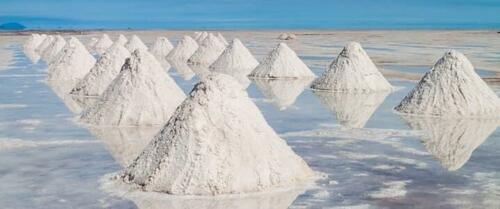
By Irina Slav of OilPrice.com
In a recent report titled Global Energy Perspective 2022, consultancy McKinsey said it expected wind and solar to become a sort of baseload generation capacity as soon as 2030. The report also had a lot of praise for the technological advances that had allowed the cost of wind, solar, EVs, and battery storage to fall substantially over the past few years
What that report didn’t say was that the “baseload scenario” will only materialize in the presence of a sufficient supply of raw materials. As a front-runner in the transition race, Europe is particularly vulnerable to any shortages of these raw materials. Because of these shortages, the transition might end before it begins in earnest.
For now, everything looks like it’s going pretty well. The prices of electric cars are on the rise but sales are still going strong, at least in part because of government incentives and in another part because of soaring fuel prices.
Yet there are clouds on the horizon.
China’s CATL, one of the majors in the battery space, recently reported a drop in its first-quarter profit because of higher production costs. What this suggests is that the company has so far absorbed the cost increases caused by tightening raw material supply but how long it would continue to do this is an open question.
Meanwhile, the CEO of Rivian, the Amazon-backed EV startup, warned of a battery shortage in the EV space. And it was a grave warning: “Put very simply, all the world’s cell production combined represents well under 10% of what we will need in 10 years,” RJ Scaringe said, as quoted by the Wall Street Journal. “Meaning, 90% to 95% of the supply chain does not exist.”
One would think that at least with wind and solar, the supply chains are there and well developed. That may be the case; however, the metals needed to feed into these supply chains are in problematic supply, especially in Europe.
Like fossil fuels, Europe has little local mining production, so it is heavily dependent on imports. To make matters a lot more complicated for it, its main supplier of aluminum, nickel, and zinc is Russia. Almost all of the lithium and rare earths used in Europe are also sourced from abroad.
"The global energy transition is progressing faster than the mining project pipeline, with copper, cobalt, lithium, nickel, and rare earths all at risk of a disruptive demand pull between now and 2035," said the authors of a study from Belgian KU Leuven University that warned Europe was facing a shortage of all the main ingredients of the energy transition.
Local production is desirable but quite unlikely, at least on a scale that would make sense. A Reuters analysis of the situation by Andy Home notes that the regulatory regime in the union is such that any new mine would take 15 years from planning to the start of production.
In other words, Europe has made it impossible for its own miners to produce the metals the continent needs to transition away from fossil fuels locally. At the same time, with its stance toward Russia and China, it is risking a lot of the current supplies of these metals and other critical materials. And this time, the U.S. can’t come to the rescue because it is struggling with reducing its own dependency on foreign sources of critical metals and minerals.
The solution? Recycling, according to the authors of the KU Leuven study. Between 2040 and 2050, the EU could come to source between 50% and 75% of the critical minerals it needs from recycling. That is, if the EU acts now to develop a recycling supply chain. And if it finds how to bridge the gap between supply and demand for these minerals in the years until 2040.
By Irina Slav of OilPrice.com
In a recent report titled Global Energy Perspective 2022, consultancy McKinsey said it expected wind and solar to become a sort of baseload generation capacity as soon as 2030. The report also had a lot of praise for the technological advances that had allowed the cost of wind, solar, EVs, and battery storage to fall substantially over the past few years
What that report didn’t say was that the “baseload scenario” will only materialize in the presence of a sufficient supply of raw materials. As a front-runner in the transition race, Europe is particularly vulnerable to any shortages of these raw materials. Because of these shortages, the transition might end before it begins in earnest.
For now, everything looks like it’s going pretty well. The prices of electric cars are on the rise but sales are still going strong, at least in part because of government incentives and in another part because of soaring fuel prices.
Yet there are clouds on the horizon.
China’s CATL, one of the majors in the battery space, recently reported a drop in its first-quarter profit because of higher production costs. What this suggests is that the company has so far absorbed the cost increases caused by tightening raw material supply but how long it would continue to do this is an open question.
Meanwhile, the CEO of Rivian, the Amazon-backed EV startup, warned of a battery shortage in the EV space. And it was a grave warning: “Put very simply, all the world’s cell production combined represents well under 10% of what we will need in 10 years,” RJ Scaringe said, as quoted by the Wall Street Journal. “Meaning, 90% to 95% of the supply chain does not exist.”
One would think that at least with wind and solar, the supply chains are there and well developed. That may be the case; however, the metals needed to feed into these supply chains are in problematic supply, especially in Europe.
Like fossil fuels, Europe has little local mining production, so it is heavily dependent on imports. To make matters a lot more complicated for it, its main supplier of aluminum, nickel, and zinc is Russia. Almost all of the lithium and rare earths used in Europe are also sourced from abroad.
“The global energy transition is progressing faster than the mining project pipeline, with copper, cobalt, lithium, nickel, and rare earths all at risk of a disruptive demand pull between now and 2035,” said the authors of a study from Belgian KU Leuven University that warned Europe was facing a shortage of all the main ingredients of the energy transition.
Local production is desirable but quite unlikely, at least on a scale that would make sense. A Reuters analysis of the situation by Andy Home notes that the regulatory regime in the union is such that any new mine would take 15 years from planning to the start of production.
In other words, Europe has made it impossible for its own miners to produce the metals the continent needs to transition away from fossil fuels locally. At the same time, with its stance toward Russia and China, it is risking a lot of the current supplies of these metals and other critical materials. And this time, the U.S. can’t come to the rescue because it is struggling with reducing its own dependency on foreign sources of critical metals and minerals.
The solution? Recycling, according to the authors of the KU Leuven study. Between 2040 and 2050, the EU could come to source between 50% and 75% of the critical minerals it needs from recycling. That is, if the EU acts now to develop a recycling supply chain. And if it finds how to bridge the gap between supply and demand for these minerals in the years until 2040.




